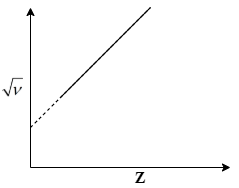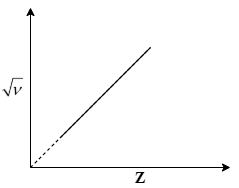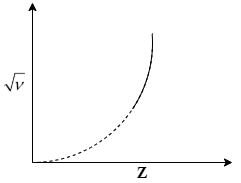Question
Question: The graph between the square root of the frequency of a specific line of characteristic spectrum of ...
The graph between the square root of the frequency of a specific line of characteristic spectrum of X-ray and the atomic number of the target will be
a)

b)

c)

d)

Solution
It has been observed that the frequency of the characteristic spectrum of X-ray and the atomic number of the target is dependent in such a way that the frequency is proportional to the square of the atomic number with an offset value.
Formula used:
Relationship between the frequency of characteristic spectrum of X-ray and the atomic number is given by:
ν=a(Z−b)2...................(1)
Where,
ν is the frequency of characteristic spectrum of X-ray,
Z denotes the atomic number of the target atom,
a is the proportionality constant and a is positive,
b is offset constant and it’s positive also.
Complete step by step answer:
From eq.(1) we get the relationship betweenνand Z as:
ν=a(Z−b)2 ∴ν=aZ−ab .............................(2)
Now, compare this eq.(2) with the equation of a straight line i.e. y=mx+c. You will see thatνand Z are linearly related to each other with slopeawith an intercept −ab. So, the line will cut x-axis at +b point. Hence, the graph of ν vs Z will look like:

Where, square roots of frequency values are given at y axis and the atomic number Z is given in the x-axis.
Correct answer:
The correct graph is given in option (b).
Note: From the given relation between frequency of characteristic spectrum and atomic number in eq.(1) a student can easily determine that the relationship betweenνand Z will be linear. But they might get confused when choosing one between the first 3 straight line options. So, you need to focus on eq.(2). You will see that the line must have a negative intercept with y-axis. But in option a and option c the intercepts are positive and zero respectively. So, you’ll get the correct answer as graph b.
